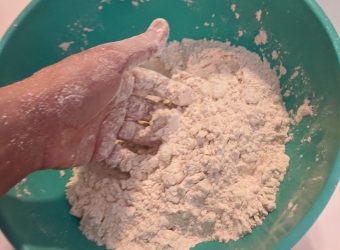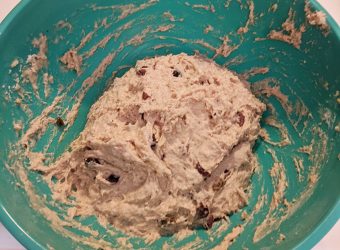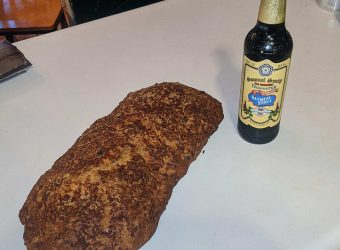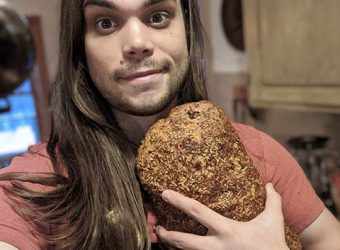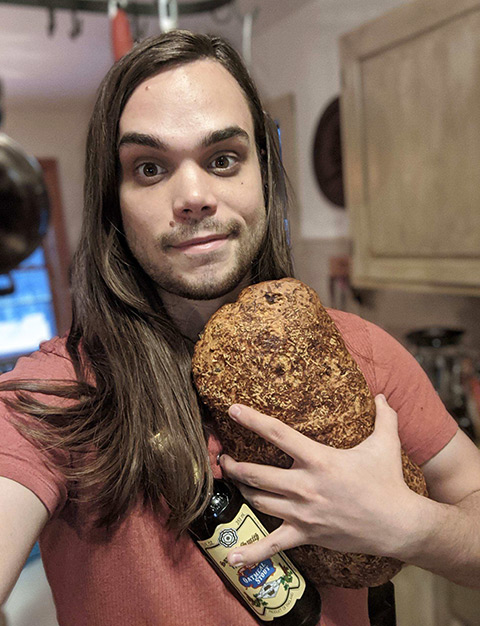 It’s time for “Chris Arndt Takes Over the Breedlove Blog,” third edition!
It’s time for “Chris Arndt Takes Over the Breedlove Blog,” third edition!
A quick intro, for those not yet acquainted: I am Breedlove’s Featured Artist for the month of January! It’s as sweet a gig as you’d imagine—I work with awesome people at an awesome company, play awesome instruments and connect with all sorts of folks that I’d otherwise never have met! And, once a week during my tenure, I get to take over the Breedlove blog. I pick a guitar from Breedlove’s Organic Collection, write a bread recipe inspired by that instrument, and then pair it all with a beer. Because what goes better with great acoustic guitars than food and drink?
Thus far, I’ve talked about the Performer Concerto in a blog post exploring homemade sourdough and wintry West Coast IPAs. I’ve also discussed the Signature Concert, pairing it with a recipe for Challah and a Bavarian wheat beer. This week, I’m taking a look at the Wildwood Companion Satin CE.
The quick breakdown:
– African mahogany top, back, sides and neck
– Indian laurel fretboard and bridge
– Companion body shape
– Satin stain finish
– 19 frets
The Wildwood Series guitars are pretty special. They’re the only Organic Collection guitars with a mahogany top; the others all feature torrefied European spruce. Plus, the satin finish is absolutely beautiful. The Wildwood Companion is the perfect travel guitar; compact, but still gorgeous, both aurally and visually. Seriously, if you haven’t yet, give it a listen. You won’t regret it.
This guitar pairs perfectly with a good soda bread. Both are accessible—the guitar is affordable and travel friendly, and the bread doesn’t require any of the special maintenance yeasted breads require. Both are rustically charming—the guitar with its satin-stained mahogany finish, and the bread with its crumbly, country-cooking appearance. And, most importantly, both will seriously impress people with how friggin’ awesome they are!
Soda bread is one of my favorite things to make. It uses chemical leavening (that’s what the baking soda does) instead of yeast, which means there’s no worrying about whether the bread will rise or trying to figure out when it’s proved the perfect amount. It’s foolproof! Plus, you don’t need to worry about adding different flavorings as much. Yeast can be pretty darn finicky; baking soda is chill AF. I’m flavoring my bread with olives, Parmesan cheese and caraway seeds.
To make this bread, you’re going to need:
- whole wheat flour
- all-purpose flour
- buttermilk (powdered works, or you can hack it—just don’t use plain milk. You need the acid!)
- regular milk (just a little bit)
- baking soda
- salt
- unsalted butter
- one large egg
- olives
- caraway seeds
- hard, salty cheese (ideally real parmesan—the stuff with the rind that says ‘parmigiano reggiano’—or pecorino romano)
- an instant-read thermometer
- some basic kitchen tools–a whisk, a few bowls, a pie pan or baking sheet, and optionally, a mortar and pestle
Do-ahead: chop up 60g of pitted olives and leave them uncovered in the fridge for a few hours, up to a day. You want to dry them out a little. Adding watery ingredients to bread can give you a weird texture.
When you’re ready to mix the dough, preheat the oven to 400F. There’s no waiting for yeast to ferment, so you can throw the dough in the oven as soon as it’s mixed. Now, chop up 70g of butter into blueberry-sized chunks and put them in the fridge to chill.
Measure a half-teaspoon of caraway seeds into your mortar and pestle. You don’t want to grind them very much; you just want to crack them open, so a couple quick whacks will do. If you don’t have a mortar and pestle, just roll the seeds between your hands with some pressure and they’ll crack a little. Whisk them in with 400g AP flour, 115g WW flour, 1 ¼ tsp salt and 1 ¼ tsp baking soda. If you’re using powdered buttermilk, whisk the powder in with these ingredients as well.
Grate 50g of your hard cheese into a smaller bowl. In a third bowl, whisk together the buttermilk (or water, if you’re using powdered buttermilk) and the large egg. Now, grab the chilled butter from the fridge and cut it into the dry ingredients like you would to make pie crust—use a pastry cutter, a few butter knives or your hands. The goal is to get small pieces of butter dispersed throughout the dough. These melt in the oven and make the bread light and flaky and awesome.
Finally, you’re ready to do the final dough mix. Place about ⅔ of your grated cheese, along with the chopped olives, into the dry ingredients; then pour the wet ingredients in and fully incorporate with a spoon. Knead a little bit until the dough just starts to come together—it should be shaggy, but not completely falling apart.
You’re ready to shape your loaf! Traditionally, soda bread is shaped into a round with a cross cut into the top like this, and then baked in a pie pan or on a baking sheet. You could also use a bread pan, if you’ve got one, to make something like beer bread. I tried to make a log, and as you can see, it ended up looking like a big turd. Still tasted great, but I’d go with one of the more traditional shapes if I were you. Whatever shape you decide to go with, don’t forget to grease your baking vessel! Also, parchment paper is your friend—you don’t need to use it, but I really recommend it when available. If not, just go extra hard on the non-stick spray or butter and you’ll be fine. As to the actual shaping, there’s really no special trick—I just sorta mush the dough around until it looks OK. Once it’s in place, glaze it with milk and sprinkle the remaining cheese on top.
Throw your dough into the 400F oven for 40–70 minutes, until the internal temp is 205F–210F. The reason the time range is so wide is because the shape of your loaf will have a huge effect on baking time—the thicker it is, the longer it’ll take the middle to reach temperature. Mine took about 65 minutes. If it starts to take much longer than that, tent the loaf with aluminum foil once you’ve gotten a color you’re happy with. I like a nice dark brown.
Once it’s up to temp, pull it out, let it cool for a while, and enjoy! It’s a pretty strongly flavored bread, so it goes really well on its own or with butter, but you could definitely make some pretty interesting sandwiches with it, too. Just don’t forget to think about the Wildwood Series while eating it.
So, there you have it—a super simple, super delicious bread to go perfectly with your Breedlove Wildwood Companion. As far as beer is concerned, I’m going with Samuel Smith Old Brewery Oatmeal Stout. It’s a classic, rich British dark beer, and the perfect drink to wash down a buttered slice of soda bread. So pour a pint, bake some bread and write a song on your Wildwood Companion. And don’t forget to tune in next week for another beer/bread/Breedlove pairing!
